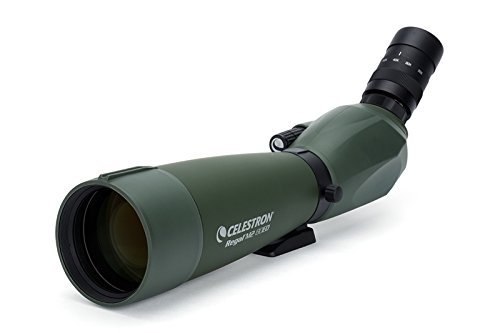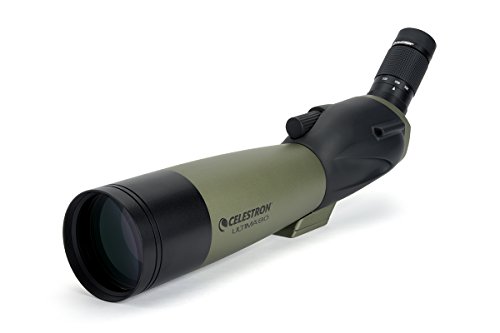10 Best Spotting Scopes for Birding in 2024 – Reviews & Buyers Guide
Last Updated on
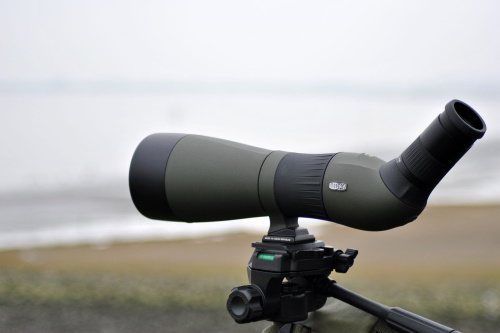
While birding, it’s pretty common for an avian subject you’re watching to fly out of view, possibly even perching just far enough that you can see it but not make out any worthwhile detail. Binoculars will only get you so far, but if you have a good spotting scope, you can see your feathered target in high detail from much greater distances.
Similar to binoculars, there are many different spotting scopes available and they come in varying magnifications, sizes, and with different lenses, features, and more. So, which ones are the best options for birding?
We set out to answer exactly that question. After testing out many of these spotting scopes, we’ve narrowed down the numerous choices to the best ones that gave us a birds-eye view of our winged subjects. Hopefully, our reviews will help you decide which one is right for you.
A Glance at Our Favorite Choices in 2024:
| Image | Product | Details | ||
|---|---|---|---|---|
| Best Overall |
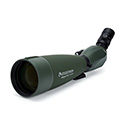 |
Celestron Regal M2 80ED |
|
CHECK PRICE |
 |
Vortex Optics Diamondback |
|
CHECK PRICE | |
| Best Value |
 |
Celestron Ultima Zoom |
|
CHECK PRICE |
 |
Vanguard Endeavor A 20-60x |
|
CHECK PRICE | |
 |
TASCO 20-60×80 |
|
CHECK PRICE |
The 10 Best Spotting Scopes for Bird Watching:
1. Celestron Regal M2 80ED Spotting Scope – Best Overall
The Celestron 52305 Regal M2 features a top-of-the-line prism with low-dispersion glass and coated optics to help maintain sharp images. It also has a large objective lens to help gather as much light as possible in overcast conditions or at dusk. It’s also waterproof—if it rains or fogs, moisture won’t seep into the body of your scope.
It’s built on a solid frame that feels flimsy but is actually very stout. Don’t confuse lightweight with junk. In this case, the lighter weight makes it pretty mobile
What we didn’t like was the eye relief, that space between the ocular lens and your eyeball. It’s pretty narrow, so if you wear glasses that will be an issue. We also found that the benefit conferred by the large objective lens tended to be diluted when used at higher magnifications. It’s also (no surprise here) pretty pricey.
However, we still think that this is one of the best spotting scopes for birding this year.
- Great value
- Angled body
- Coated optics
- Large objective lens
- Lightweight
- Higher magnification degrades large objective benefits
- Poor eye relief
- Pricey
2. Vortex Optics Diamondback Birding Spotting Scope
The best way to describe the Vortex Optics Diamondback is that it delivers big things in a really small package. It maintains sharp, colorful images in a lightweight, compact frame so that you can feel like you’re up close and personal with the birds you’re tracking.
The optics are superior and maintain details that are critical for a good birding scope. It’s also water- and fog proof; if it gets wet while you’re out in the woods, you don’t have to worry about moisture getting into your scope and ruining your images. The scope also comes with a built-in sunshade, which is handy during sunny, cloudless days.
Focusing can be a bit of a trick, but that’s not the real drawback. The real drawback is the price. This one is really expensive. You get a lot of scope for it, but you can get comparable quality for less. That’s why, when it comes to the best spotting scopes for birding, we dropped it to the runner-up spot.
- Built-in sunshade
- Weatherproof
- Lightweight
- Really pricey
- Focusing can be tricky
Check Out: Best Vortex Spotting Scopes
3. Celestron Ultima Zoom Bird Spotting Scope – Best Value
Related to our top pick, the Celestron 52250 Ultima Zoom packs great optics into a waterproof frame. It will let you scope out birds from a comfortable distance with details that will enable you to identify their species with confidence. It’s also pretty affordable, which is why it gets our “Best for the Money” choice.
It’s got great features for its optics. The multi-coated glass will reduce light lost due to reflection and will help keep images looking fresh and sharp. It’s also got a nice large objective lens to help gather light in low-light conditions like dusk and on overcast days.
What we didn’t like was the eye relief, that space between the ocular and the eyepiece. If you wear glasses, they will get in the way. We also found the weight distributed poorly, with more of it on the front end than the back. It might tip during use if you’re not careful.
- Good optics
- Durable
- Great value
- Poor eye relief
- Forward weighted
4. Vanguard Endeavor A 20-60x Bird Spotting Scope
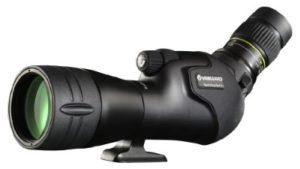
Vanguard’s Endeavor has all the right features for its optics. It just somehow can’t pull it all together and deliver the goods with them. It’s still one of the best spotting scopes for birding, bit it’s just not a really good value.
We can’t quite understand it. It’s got low-dispersion glass and coated glass to help keep images sharp and reduce color bleeding. It’s lightweight but durable, and it’s waterproof to keep water out if it rains or gets foggy.
It has a lot of potential, but the scope just can’t seem to live up to it. The images, for all the features, just aren’t all that sharp and are just about grainy in low-light conditions. It’s not as costly as some of the other models we looked at, but it’s still a pretty underwhelming scope. It’s also not a very good value as a purchase which, considering the price, is a pretty serious drawback.
- Great optics
- Not really very sharp images
- Not a good value
5. TASCO 20-60×80 Spotting Scope for Bird Watching

TASCO’s World Class isn’t a terrible scope for birding, it’s just an awfully large scope to lug around when chasing birds. Of course it’s big, and it’s got a nice-sized objective lens that needs to be supported by a frame of similar size.
It’s also—compared to the other models we looked at—pretty inexpensive. It’s also weatherproof, so it’ll keep the rain and fog out.
Beyond that, it’s just not a very good scope. Its images are of the kind of quality you’d expect to get from a scope of this price. There aren’t a lot of extras to help clean up the images. What you see is what you get, plus distortion, blurring, and color bleeding. It also comes with a tripod, which we suggest that you throw out with the packaging. Get a different one.
- Inexpensive
- Weatherproof
- Quality not very high
- Tripod is not great
- Overpriced
- Big
6. Bushnell Trophy Xtreme Spotting Scope
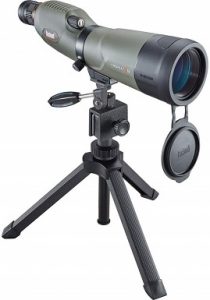
Birding takes place out in nature where you’re often subject to nature’s whims. The elements can be rough on our expensive birding devices, which is why the Bushnell Trophy Xtreme Spotting Scope has been built tough to withstand adverse weather conditions. It’s covered in a rubber armor that’s not only shock-absorbing but it’s waterproof as well. And just in case anything should happen to your scope, your investment is protected by the Bushnell no questions asked lifetime warranty.
This scope has standard tripod mounting threads so you can easily attach it to any tripod. A mini tabletop tripod is even included with the scope, though it’s not very sturdy.
The zoom on this spotting scope ranges from 20x-60x, giving you plenty of magnification to see those far off birds that would normally be out of binocular range. But the highest levels of magnification can lose some clarity, especially if weather conditions aren’t perfect.
Thanks to the 65-millimeter lens, you get great image quality but the device remains compact. It’s still small enough to bring along on your next outing, even though it will give you the ability to see hundreds of yards farther than binoculars.
- Zoom magnification from 20x-60x
- Includes tabletop tripod
- 65mm lens is a good blend between size and image quality
- 100% waterproof construction
- Lifetime warranty
- The included tripod isn’t very sturdy
- Low clarity towards the upper end of the magnification range
7. Roxant Authentic Blackbird High Definition Spotting Scope with Zoom

It’s certainly not the highest quality scope on the market, but the Roxant Authentic Blackbird High Definition Spotting Scope offers a great image and some excellent features for a very affordable price. It’s lacking in the magnification department, though the zoom still provides a respectable 12X-36X magnification. Roxant defends this choice by saying that higher levels of magnification on other low-priced spotting scopes aren’t usually usable; we’d tend to agree.
The image quality of this scope is very good. It’s not on par with the high-end scopes we tested, but for a fraction of the price, this scope has pretty darn decent optics. Even better, it’s very compact and lightweight, making it easy to take in the field. It’s just shy of nine inches long and weighs barely over a pound. You’ll barely notice it in your pack.
Thankfully, this scope is built to be durable. It’s covered in a tough rubber armor that not only protects the scope but also provides non-slip texture for easier holding and viewing. But if any accidents should happen, you’re covered by the Roxant lifetime replacement guarantee.
- Affordably priced
- Lifetime replacement guarantee
- Weatherproof and durable
- Compact and lightweight
- Not as much magnification as other models
- Mediocre magnification
8. LANDOVE 20-60X80 BAK4 Prism Spotting Scope
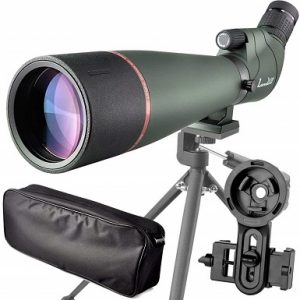
For a 20x-60x magnification zoom equipped spotting scope with an 80-millimeter lens, the LANDOVE spotting scope is priced quite affordably. Its quality isn’t on par with the higher-end scopes, but at this price, you shouldn’t expect it to be.
Up to 300 yards, you get a decent image. It always seems a bit dim, especially given the large objective lens, but the image is decent. Once you zoom past that, you’ll start to see a lot of blur in the image. If you’re looking for a spotting scope that will allow you to clearly see birds at 500 yards or more, you’ll probably have to look at a model with a slightly higher price tag.
Another issue with this device is the small eyepieces. When looking through them, the image you see is very small. So, even when viewing subjects within that 300-yard range, it can still be difficult to make out details. Though it’s not a bad scope, if you want to do serious birding you should look for something with a higher image quality past 300 yards.
- Includes adapter for cell phone
- Affordably priced
- Zooms from 20x-60x magnification
- Has a dim picture
- Small eyepieces means the image you see is small
- Not great past 300 yards
9. Emarth 20-60x60AE Waterproof Angled Spotting Scope with Tripod
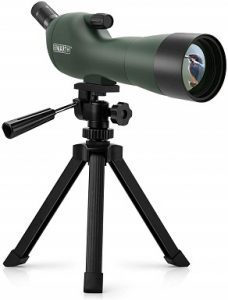
The dirt-cheap pricing of the Emarth Waterproof Angled Spotting Scope might attract you, but the low quality means it’s not the best choice for serious birding. It does have 20x-60x zoom magnification, but of that, about half is usable. Once you get past 40x magnification, it becomes very difficult to get any sort of clear image with this scope.
Because it has a 45-degree angled eyepiece, this scope can be comfortable to use in some situations. But it’s held back by the eyepiece. It doesn’t rotate, so you can’t change the angle. Worse, you have to get so close at higher magnifications that you can’t use any type of eyewear with this scope.
If you zoom in, you’ll discover that your field of view is extremely narrow. This makes it difficult to locate small subjects like birds off in the distance. Combined with the poor image quality past 40x magnification and it makes this scope a poor candidate for birding.
- Dirt cheap
- 20x-60x magnification
- Can’t use eyewear with this scope
- Not great at long distances
- About half the magnification is clear
- Narrow field of view
10. Barska 30-90×90 Waterproof Colorado Spotter Scope and Tripod
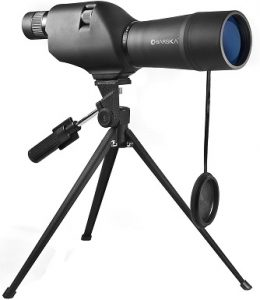
The Barska 30-90×90 Waterproof Colorado Spotter Scope seems like a great scope on paper. It’s got a zoom range of 30x-90x, making it one of the most powerful scopes we’ve tested. With a large 90-millimeter objective lens on the front, we figured that you might actually be able to use some of that zoom. Unfortunately, we were wrong.
While you can use the first portion of the magnification and get a pretty clear picture, it’s never quite sharp like some of the nicer models we tested. Past 40x magnification, the picture gets blurry and it’s practically unusable past 60x. Turns out, all that extra magnification wasn’t much good!
That large 90-millimeter lens didn’t seem to let any extra light in. The image was dim. When you were using it in low light, you couldn’t see anything of use. And the poor eye relief meant you had to be right up on the eyepiece to see anything, so it’s not suitable for those with eyewear.
But that big lens did mean one thing; this is a big, bulky device. It’s not something we’d like to carry too far, so it’s probably not the best choice for birding.
- 30x-90x zoom
- Includes an extendable tripod
- Waterproof
- Included tripod is unstable and weak
- Dim view
- Poor low-light performance
- Poor eye-relief
- Big and bulky, thanks to large 90mm objective lens
Buyer’s Guide – Choosing the Best Spotting Scope for Bird Watching
If you’re still unsure of which scope to pick for birding after reading our reviews, don’t worry. We’ve written this short buyer’s guide to help you narrow down the important factors and make the right decision.
What to Look for in a Birding Scope
When you’re looking at spotting scopes for birding for the first time, the sheer amount of specs and terms can be overwhelming. Magnification, field of view, lens coatings, lens sizes; it can all be pretty confusing. Let’s break down some of these terms a bit more and discuss how it affects your scope and the image you see so you can make your decision from a more informed place.
Magnification
Magnification is the measure of how much larger an image appears when viewed through your device. It’s expressed by a number followed with an x. For instance, 20x magnification means that objects will appear 20 times closer or larger than with the naked eye.
For a spotting scope to be useful for birding, it has to have more magnification than your binoculars. Many offer zooms that will give you a broad range of magnification levels.
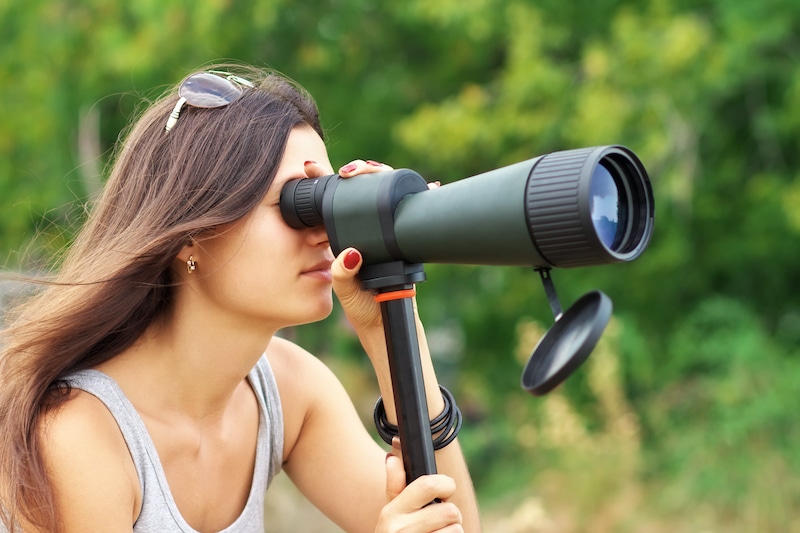
Keep in mind that high magnification isn’t always usable. 60X magnification is only usable if the glass used for the lenses is of high quality. Even then, weather conditions can drastically affect the image quality at such high levels of magnification.
Field of View
Field of view is how much area you can view at once through your device. It’s usually measured at a distance of 1,000 yards. Spotting scopes will always have smaller fields of view than binoculars since they have higher magnification.
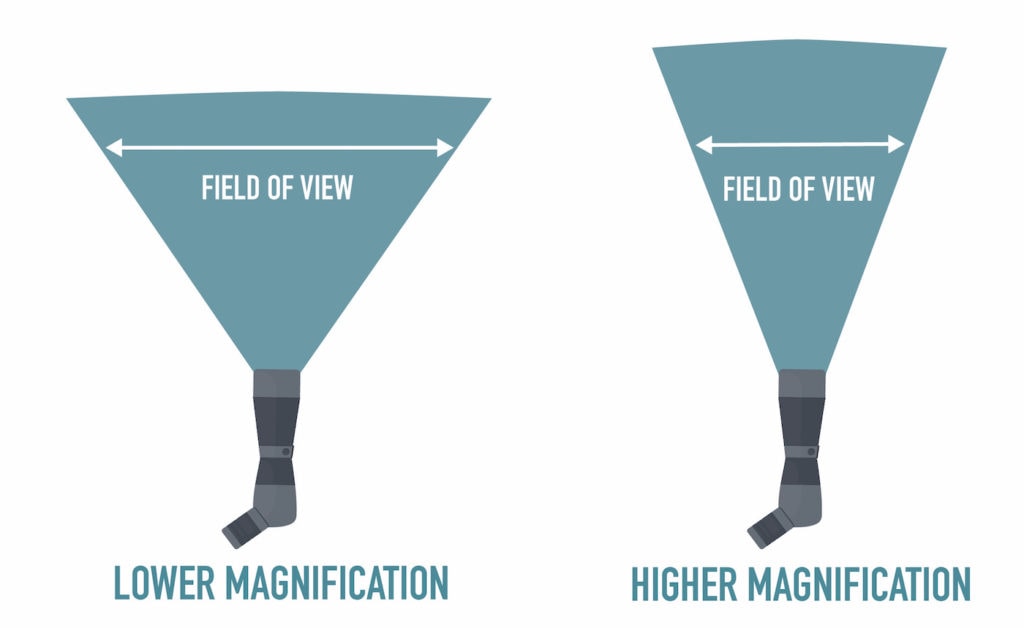
In general, you want the largest field of view possible for birding. If your field of view is too narrow, you’ll have a hard time finding your subject in your scope. You might be able to see it off in the distance with your bare eye, but if the field of view is small in your scope, you’ll have a hard time finding that tiny target, especially if it’s moving.
Objective Lens
The objective lens sits at the front of your scope and takes in light to provide you with an image. A larger objective lens lets in more light for a brighter image with better detail.
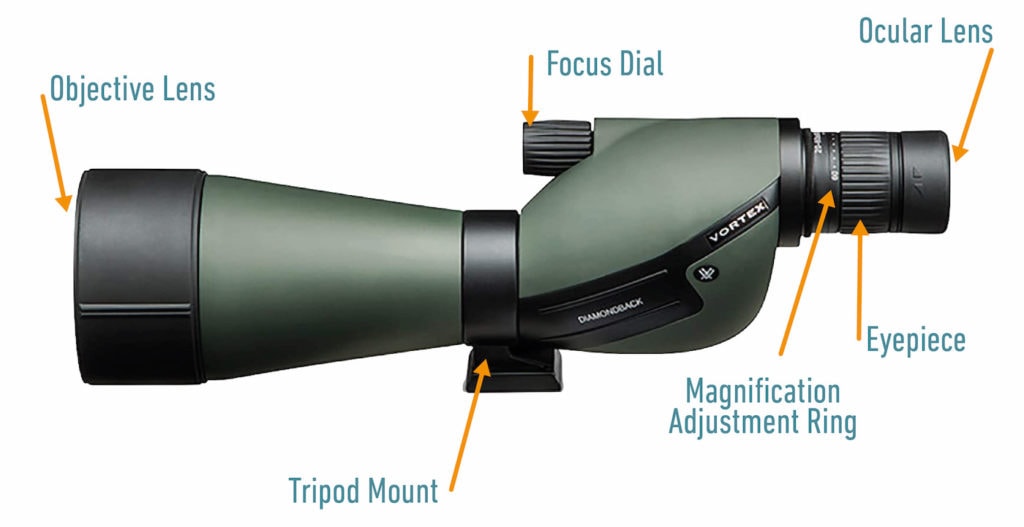
You’d be forgiven for thinking this means you want to find a scope with the largest objective lens possible. While this might result in a high-definition image, there are other factors at play. For instance, lens quality. A larger lens isn’t always better. A smaller objective lens of a higher quality might produce a clearer image.
- Also, keep in mind that a larger objective lens means a larger scope overall. This can make it a nuisance when carrying it out in the field.
- For birding, you’ll probably want an objective lens between 60-85 millimeters for the best blend of a clear image and a compact device.
Size
How far do you trek to locate rare avian specimens? If you spend hours in the field covering long distances, then you’ll want to consider the size of your scope. Larger scopes tend to be heavier, and that big bulky scope can be a pain to carry with you through trails and wilderness alike.
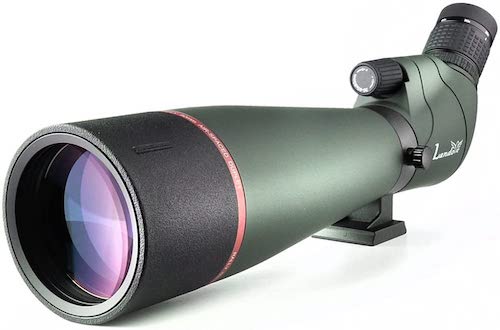
Of course, larger scopes are often the ones with the best capabilities. Large objective lenses allow for high-definition images at long distances and they can even provide better low-light performance. But you’ll have to weigh that against the overall size of your scope if you don’t want to lug around the extra weight of that big lens.
Durability
Since your scope is going to be doing most of its spotting under the open skies, it will likely be introduced to some adverse weather elements. Not only that, but trees, rocks, and more provide hazards as you trek towards that perfect vantage point.
To combat the likelihood of your expensive scope getting damaged, look for one that’s built rugged to endure these conditions. Many are covered in tough armor that will protect them from scratches and impacts. Likewise, many scopes today are waterproof and fog-proof so they can handle whatever nature throws at them while you search for your next feathered subject.
Price
At the end of the day, it doesn’t matter how many fancy features you’d like to have on your spotting scope. Most of us are limited by something much more realistic; our budget.Spotting scopes vary widely in price and capability. Some are very affordable, others are astronomically expensive. While it’s true that you often get what you pay for, that doesn’t mean you have to break the bank to get a usable spotting scope.
Look for the spotting scope that has the most useful features inside of your price range. Even at the low end of the price spectrum, there are excellent spotting scopes available that will help capture your next avian encounter in spectacular detail.

Conclusion
In our reviews, the Celestron 52305 Regal M2 was the king. You pay for it, but you get quite a lot for the price. The Vortex Optics Diamondback was a reasonably close second, but price and difficulty in focusing brought it down in our eyes. The Celestron 52250 Ultima Zoom was our “Best for the Money,” out-delivering in quality while under-demanding in price. We felt the Vanguard Endeavor simply didn’t live up to the potential of its features. The TASCO World Class was a bit too big to carry around for birding. They could have taken the money they spent on what is an atrocious tripod and put it into better optics.
We hope you found our reviews helpful and took something from our buyer’s guide that will help you make a better choice in finding the best birding scope for your needs. We wish you the best of luck in finding new and interesting species of birds.
Table of Contents
- A Glance at Our Favorite Choices in 2024:
- The 10 Best Spotting Scopes for Bird Watching:
- 1. Celestron Regal M2 80ED Spotting Scope – Best Overall
- 2. Vortex Optics Diamondback Birding Spotting Scope
- 3. Celestron Ultima Zoom Bird Spotting Scope – Best Value
- 4. Vanguard Endeavor A 20-60x Bird Spotting Scope
- 5. TASCO 20-60×80 Spotting Scope for Bird Watching
- 6. Bushnell Trophy Xtreme Spotting Scope
- 7. Roxant Authentic Blackbird High Definition Spotting Scope with Zoom
- 8. LANDOVE 20-60X80 BAK4 Prism Spotting Scope
- 9. Emarth 20-60x60AE Waterproof Angled Spotting Scope with Tripod
- 10. Barska 30-90×90 Waterproof Colorado Spotter Scope and Tripod
- Buyer’s Guide – Choosing the Best Spotting Scope for Bird Watching
- Conclusion
About the Author Robert Sparks
Robert’s obsession with all things optical started early in life, when his optician father would bring home prototypes for Robert to play with. Nowadays, Robert is dedicated to helping others find the right optics for their needs. His hobbies include astronomy, astrophysics, and model building. Originally from Newark, NJ, he resides in Santa Fe, New Mexico, where the nighttime skies are filled with glittering stars.
Related Articles:
How to Clean a Refractor Telescope: Step-by-Step Guide
How to Clean a Telescope Eyepiece: Step-by-Step Guide
How to Clean a Rifle Scope: 8 Expert Tips
Monocular vs Telescope: Differences Explained (With Pictures)
What Is a Monocular Used For? 8 Common Functions
How to Clean a Telescope Mirror: 8 Expert Tips
Brightfield vs Phase Contrast Microscopy: The Differences Explained
SkyCamHD Drone Review: Pros, Cons, FAQ, & Verdict




